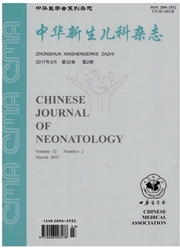

 中文摘要:
中文摘要:
目的 探讨本院新生儿败血症病原菌的分布及耐药情况,指导临床合理使用抗生素,促进医院感染的有效防控.方法 对2006年1月至2011年5月我院新生儿科收治的败血症患儿进行回顾性分析,按照发病时间分为早发型败血症及晚发型败血症,并根据发生感染的地点分为社区获得性感染及医院感染.结果 研究期间共收治新生儿败血症121例.早发型败血症50例(41.3%),病原菌以革兰阴性杆菌为主,共40例(80%),其中含产超广谱β内酰胺酶(ESBLS)株5例(10%),革兰阳性凝固酶阴性葡萄球菌10例(20%).晚发型败血症71例(58.6%),其中社区感染56例(78.9%),病原菌以革兰阳性球菌为主,共30例(42.2%),革兰阴性杆菌26例(36.6%);医院感染15例(21.1%),革兰阴性杆菌7例(9.9%),其中产ESBLs株4例(5.6%),革兰阳性凝固酶阴性葡萄球菌4例(5.6%),真菌4例(5.6%),均为白色念珠菌.结论 早发型败血症及晚发型败血症、社区获得性败血症及医院感染败血症病原谱不同,均有多重耐药菌产生.
 英文摘要:
英文摘要:
Objective To study the distribution and drug resistance of pathogens in neonatal septicemia in order to provide clinical guidance for antibiotic usage and to prevent nosocomial infection.Methods This retrospective study analyzed blood culture and drug sensitivity results from 121 confirmed neonatal septicemia patients who were admitted to the Guangxi Women and Children Health Hospitalbetween January 2006 and May 2011.Infants were assigned to early-onset and late onset neonatal sepsis groups based on time of admission.They were further assignedto community-acquired and hospitalacquired infection groups according to the location of infections.Results Of 121 infants,50 had earlyonset neonatal sepsis (41.3%).Among the infants of this group,20% (10/50) were culture positive for Gram-positive Coagulase-negative staphylococci; the rest (80%,40/50) were positive for Gramnegativebacilliincluding 5 infants (10%) who were infected with Extended-spectrum β-lactamase Resistance bacteria (ESBL).78.9% (56/71) of the infants admitted for late-onset sepsis had community-acquired infections and were culture positive for gram-positive cocci (30 cases) and gramnegativebacilli(26 cases).Among the 15 infants (21.1%) who were treated for hospital-acquired late onset infection,the bacterial distributions were:7 cases of gram-negative bacilli including 4 cases of ESBLs bacteria; 4 cases of β-lactamases producing Gram-negative bacilli; and 4 cases of candida albicans.Conclusions Although pathogenic distributions are different among infants with early-onset,community-acquired or hospital-acquired later-onset neonatal sepsis,multiple drug resistant bacteria were identified in all three groups of patients.
 同期刊论文项目
同期刊论文项目
 同项目期刊论文
同项目期刊论文
 期刊信息
期刊信息
